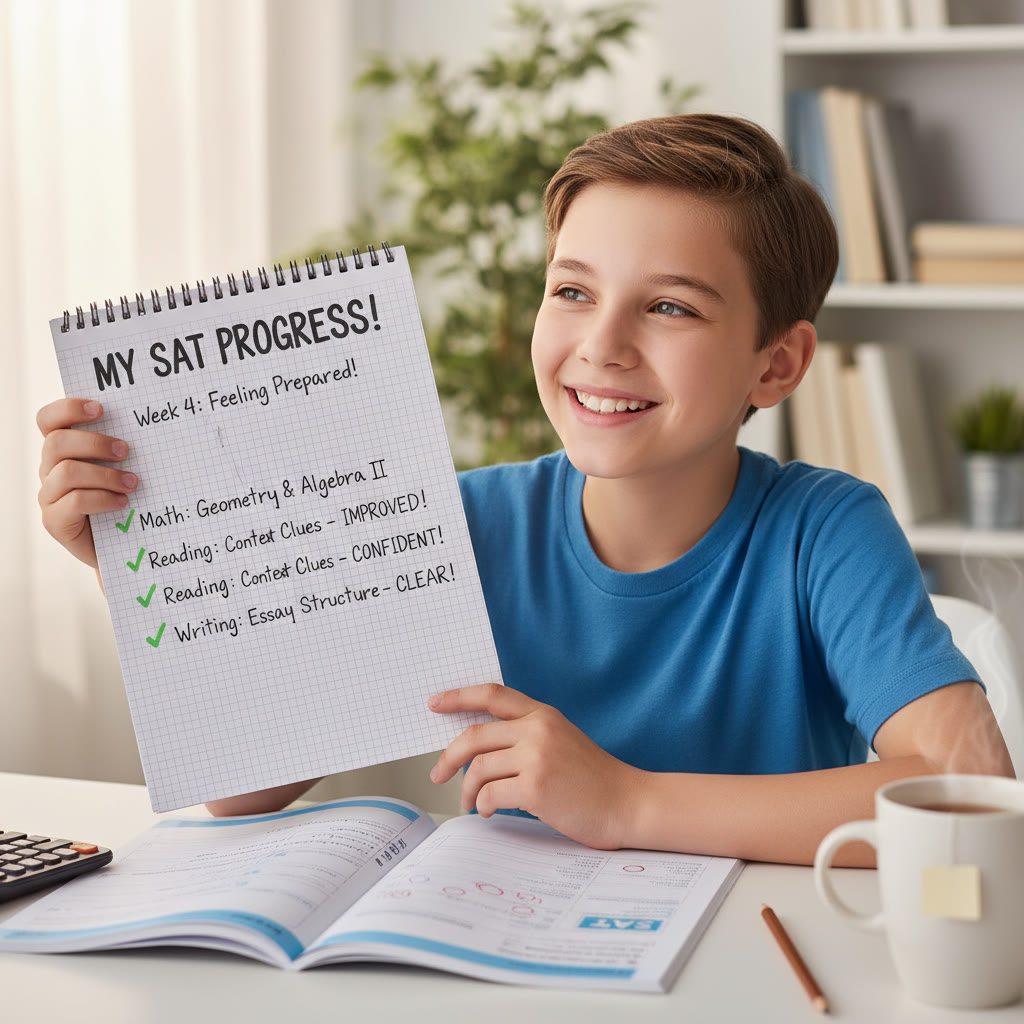Why Focused Practice Builds SAT Confidence
There’s a special kind of calm that comes the morning you walk into your SAT test center and know, deep down, that you’ve done the work. That calm isn’t magic—and it isn’t luck. It’s the product of focused practice. In this blog we’ll unpack why targeted, deliberate practice is the fastest route to both higher scores and steadier nerves, how to structure practice so it sticks, and practical ways to measure your progress so confidence grows with every week of study.

The difference between practice and focused practice
Most students practice. They take a few full-length tests, drill a few vocabulary lists, and solve a variety of math problems. That’s useful, but it’s scattershot. Focused practice is different: it’s intentional, measurable, and centered on the smallest possible unit that needs improvement—a skill, question type, or timing habit. When you focus, every minute of study has a clear purpose.
Think of it like playing music. Running through an entire concerto over and over might keep you familiar with it, but isolating a tricky phrase and repeating it with different tempos and dynamics is what makes the phrase reliable under pressure. SAT prep works the same way.
Why focused practice builds confidence faster
- Clarity reduces anxiety: Knowing exactly what to work on removes the overwhelming feeling of “I don’t know where to start.”
- Small wins compound: Mastering a 5–10 minute skill raises your belief in your ability to master the bigger things.
- Feedback loops tighten: When practice is targeted you can measure progress quickly and adjust methods without wasting time.
- Strategy becomes automatic: Repeated, focused exposure turns conscious strategies into unconscious habits you can rely on during the test.
How to identify where focused practice matters most
Every student’s path is different. The first step is diagnosis: figure out the exact points where mistakes occur or where time drains live. A single, full-length practice test is a great starting point—but the gold is in analyzing that test.
Actionable steps for diagnosing weakness
- Chunk your practice test by section and question type (e.g., grid-in algebra, evidence-based reading, command of evidence).
- Note whether mistakes are conceptual (you don’t understand the math), careless (you misread), or strategic (poor pacing or choice elimination).
- Look for patterns across multiple tests—one off mistakes are normal, repeated ones require focused intervention.
Here’s a quick, typical pattern I see: a student misses trigonometry questions because they don’t set up the triangle properly (conceptual), runs out of time on Reading because they linger too long on passage 2 (timing), and gets careless in Writing because they rush through sentence errors near the end of the section. Each problem calls for a different kind of focused practice.
Designing a focused practice plan
A focused plan is manageable, measurable, and repeatable. It has three parts: identify, isolate, and iterate.
1. Identify
Use a practice test to find the top three trouble spots. Be specific. Instead of “Reading,” write “Active passage mapping for dense science passages,” or instead of “Math,” write “Linear equations with fractions and distribution errors.” Precise labels make practice efficient.
2. Isolate
Break the skill down into the smallest learnable chunks. If the issue is reading dense passages, isolate the habit of writing a one-sentence passage summary within 60 seconds. If the issue is algebra errors, isolate distribution and fraction simplification problems and drill five in a row without error.
3. Iterate
Repeat the isolated drills with brief reflection: what did you notice? What strategy helped? Then return to mixed practice and measure transfer of the skill into real SAT-style questions.
Sample weekly focused practice schedule
This is a sample plan for a student studying 10–12 hours per week with a goal of improving 80–120 points over three months. Adjust times and targets to fit your schedule.
| Day | Session | Focus | Time |
|---|---|---|---|
| Monday | Skill Drill | Algebra foundations (distribute, combine like terms) | 60 minutes |
| Wednesday | Timed Practice | Reading passage mapping (dense science) | 60 minutes |
| Friday | Mixed Practice | 30 targeted math problems + 20 reading questions | 90 minutes |
| Saturday | Full Section | One timed Math section | 35 minutes |
| Sunday | Review & Reflection | Analyze mistakes, update plan | 45–60 minutes |
Adjust the frequency and focus as you progress. The key is consistency and making sure every session has a one-line objective.
Tracking progress: make confidence measurable
Confidence is an internal state, but you can build objective signals that reflect it. Measuring both skill performance and comfort under timed conditions creates a paired score: how well you do and how comfortable you felt doing it.
Simple tracking metrics
- Accuracy on targeted drills (percent correct across a 10-question set).
- Average time per question on timed sets.
- Self-rated confidence (1–10) after each timed session.
- Transfer rate: percent of targeted skill errors made on mixed practice after focused drills.
| Week | Targeted Skill | Accuracy | Avg Time/question | Confidence (1-10) |
|---|---|---|---|---|
| 1 | Algebra distribution | 70% | 2:30 | 5 |
| 4 | Algebra distribution | 88% | 1:45 | 7 |
| 8 | Algebra distribution | 95% | 1:20 | 9 |
Seeing progress in a table like this turns vague confidence into visible momentum. When your accuracy climbs and your time drops, your mindset follows.
Psychology of confidence: why repetition reduces test anxiety
Our brains are prediction machines. Anxiety spikes when outcomes are uncertain. Focused practice converts uncertainty into prediction: “I expect to see a dense science passage; I will map it in 60 seconds and find main idea sentences.” The more often that prediction is confirmed in practice, the less fear you feel on test day.
There’s a second psychological benefit: mastery experiences. Psychologists call these the most powerful source of self-efficacy—feeling capable because you’ve succeeded. Focused practice engineers repeated mastery experiences, each one cementing belief.
Practical mental habits to pair with practice
- Use short pre-test rituals: two deep breaths, a 10-second glance at your watch, and a reminder of one strategy you’ve mastered.
- Keep a small victory log: three things you did well in each study session.
- Visualize executing a skill under pressure—imagine the environment and your calm responses.
Examples: focused practice in action
Example 1: Emily, a junior who consistently missed function notation questions, isolated the exact error—misreading f(x) when the problem asked for f(2x). Her plan: ten function-notation problems daily for two weeks, with immediate self-explanation for each answer. After targeted practice she moved from 60% to 92% accuracy in that question type and found the same problem no longer caused a spike of doubt in mixed sections.
Example 2: Marcus struggled with pacing in the Reading section. He isolated passage selection and taught himself to spend no more than four minutes on a single paragraph-level question by practicing with a stopwatch and pausing after each passage to summarize it in one sentence. Two weeks later his time per passage dropped and he had extra minutes to check answers, which boosted his accuracy and lowered his stress.
How tutors and technology amplify focused practice
Focused practice is powerful on its own, but the right guidance can accelerate the process. Personalized tutoring—like the 1-on-1 guidance Sparkl provides—helps students diagnose hidden errors faster and builds tailored study plans that prioritize the highest-leverage skills. Expert tutors can demonstrate problem-solving heuristics, observe habits you miss, and adjust practice drills to make them more effective.
AI-driven insights, when used well, add another layer: they can analyze patterns across many practice sessions to spot persistent blind spots, suggest question sequences that reinforce learning, and recommend optimal timing for review. Sparkl’s personalized tutoring combines human expertise with intelligent insights to keep practice both focused and smart.
When to bring a tutor into your focused practice
- If you’ve plateaued despite consistent practice.
- If you can’t reliably identify your weakest subskills.
- If you need an accountability structure and custom pacing.
Common pitfalls and how to avoid them
Even with good intentions, students can derail focused practice. Here are common traps and fixes:
- Trap: Rotating too many focuses at once. Fix: Limit to one or two micro-skills per week.
- Trap: Skipping analysis of incorrect answers. Fix: Spend as much time reviewing a mistake as you did solving the problem.
- Trap: Practicing without timing context. Fix: Include timed drills frequently to ensure skills transfer under pressure.
- Trap: Using broad full-length tests as the only practice. Fix: Pair them with focused drill days and immediate targeted reviews.
Quick checklist: set up a focused practice session
- Choose a single micro-skill to target (write it down).
- Gather 8–12 practice items that isolate that skill.
- Decide on timing and success criteria (e.g., 90% accuracy in two consecutive sets).
- Practice, then immediately review each answer with a short written note.
- Return to mixed practice within 48 hours to test transfer.
Putting it all together: a three-month roadmap
Month 1: Diagnose and establish micro-skills. Run two full-length tests, identify top 6 micro-skills, and begin drilling three per week. Build the habit of tracking accuracy and confidence.
Month 2: Intensify and measure transfer. Increase timed mixed practice and review transfer rates. If one skill isn’t transferring, keep the same micro-drills but change the context (e.g., from isolated problems to SAT passages).
Month 3: Simulate pressure and taper. Introduce full-length, proctored simulations at realistic intervals. Focused practice continues but shifts to shoring up final weak spots and polishing pacing strategies.
Final thoughts: confidence is practice-shaped
Confidence isn’t a personality trait you’re born with; it’s a practical result of repeated, focused action. When study becomes strategic rather than busy, you get the double benefit of better scores and a steadier mind. Focused practice breaks the SAT down into manageable pieces, lets you win repeatedly, and builds a reliable toolkit you can carry into test day.
If you want help turning diagnostic results into a focused practice plan, Sparkl’s personalized tutoring offers 1-on-1 guidance, tailored study plans, expert tutors, and AI-driven insights to make every practice minute count. The right plan accelerates progress and protects your confidence from the usual ups and downs of studying.
Study with intention, measure what matters, and celebrate the small wins. Confidence is the quiet companion of preparation—and with focused practice, it becomes something you earn, day by day.


















No Comments
Leave a comment Cancel